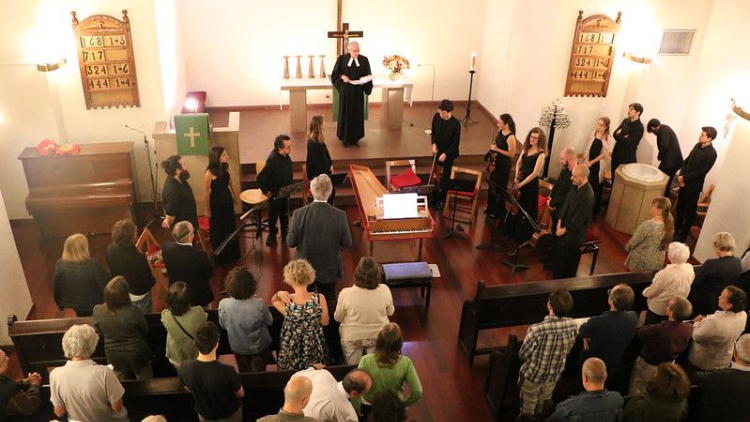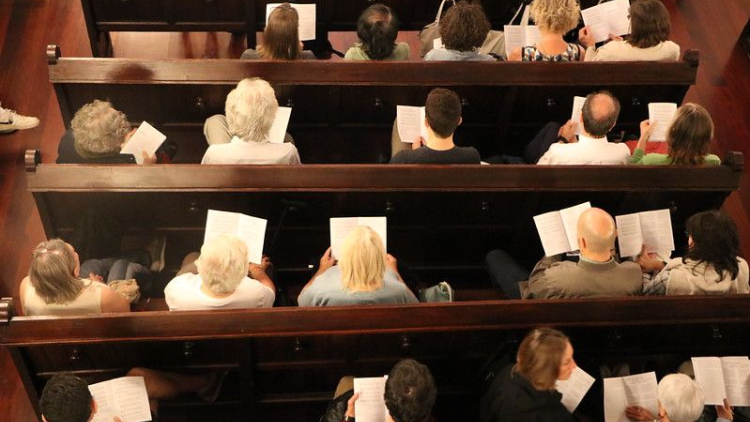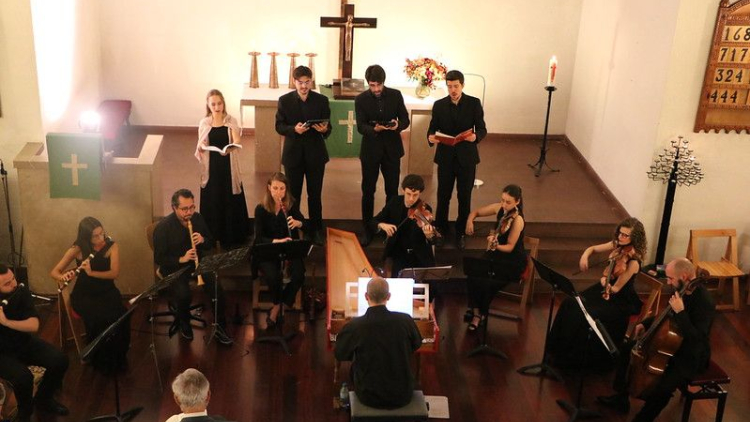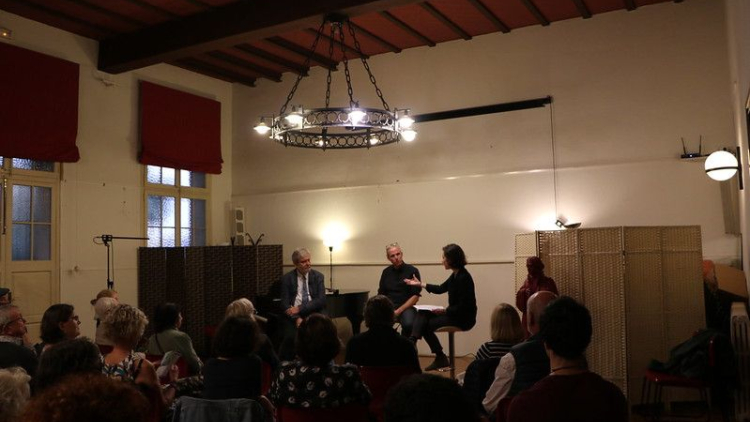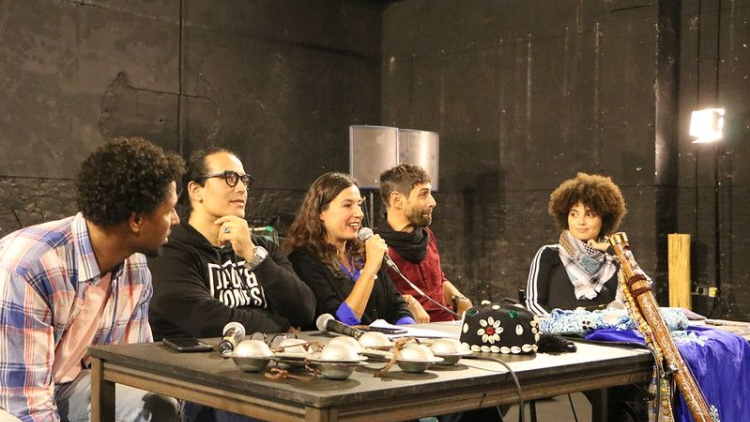#Trànsits 2023-2024 (chronicle of the autumn sessions)
The ‘Trànsits: músiques de l’esperit’ [Transitions: Music of the Spirit] series, organised by the Barcelona Music Museum and the Religious Affairs Office (OAR) as part of L’Auditori’s ‘Poder o revolta’ [Power or Revolt] season launched its second edition last autumn. The activities ‘Licht der Sinnen: The Music of the Lutheran Reform’ and ‘Gnawa Night: Music and Transitions in Morocco’ were held in October and November 2023. Attendees were able to enjoy an introductory conversation with experts from each community, as well as a performance of their respective musical practices within a spiritual or liturgical context.
Historically, there have been very close ties between music and religious and spiritual practice. Sound has been used in many cultures as a vehicle for drawing closer to the deity and moving towards transcendence, and it is found in many different spheres in ceremonies, rituals or forms of worship which have survived until today by adapting to the passage of time, political conflicts and migratory movements. With the goal of continuing this tradition, different Barcelona communities feature in the series entitled ‘Trànsits: músiques de l’esperit’ [Transitions: Music of the Spirit], organised by the Barcelona Music Museum and the Religious Affairs Office (OAR).
The series aims to highlight Barcelona’s cultural and especially religious diversity through the different bonds that the belief systems that coexist in the city create with music. In the interview recently published on the OAR website, Jordi Alomar, director of the Barcelona Music Museum and the driving force behind this series, explained that the title ‘Trànsits’ [Transitions] refers to a state as well as a passage, a change in contexts, spaces or repertoires. Thus, the different sessions already held and scheduled for the upcoming months aim to spotlight Barcelona’s cultural, religious and spiritual diversity by displaying a wide range of practices in which music plays a prime role.
After its first edition, which kicked off in 2022, and as part of the Auditori’s ‘Mort o retorn’ [Death or Return] season, this series is continuing in 2023 and 2024 with its second edition, this time as part of L’Auditori’s ‘Poder o revolta’ [Power or Revolt] season. It began in October with the session ‘Licht der Sinnen: The Music of the Lutheran Reformation’ and continued in November with ‘Gnawa Night: Music and Transitions in Morocco’. A third session, ‘Barak. Musics of Light in Hanukkah’, was scheduled for December, but unfortunately it had to be cancelled.
All the sessions consist of a prior conversation with experts on the connection between music and spirituality from the community featured in the activity, and an performance session in which the same community carries out a religious or spiritual practice in which music, song or sound plays a key role.
LICHT DER SINNEN. BACH AND GERMAN PROTESTANTISM
‘Licht der Sinnen: The Music of the Lutheran Reform’ was held on 21 October 2023 at the German Speaking Lutheran Evangelical Church, one of the city’s historical churches, which continued the tour through the evangelical churches that was started in the first edition of the series as part of the session entitled ‘Paths of the Soul: The Music of the Evangelical Churches’. The activity began with a conversation with Matthias Weinmann, cellist and coordinator of community activities; Oliver Spies, evangelical pastor; and Anna Clot, sociologist. Next, a liturgical service was held in which soloists from Salvat Beca Bach and the Bachcelona Consort performed several of the more than 200 pieces that Johann Sebastian Bach composed, associated with certain readings prescribed by the Lutheran liturgical calendar.
The session exemplified the importance of music to Protestantism; indeed, according to the thinking of Martin Luther, the driving force behind the Protestant Reformation in the sixteenth century, music was a core element of divine service, a vehicle of faith. And the different corpuses of hymns and cantatas written in German to facilitate their use and dissemination were one of the cornerstones of the establishment and spread of Lutheranism. In the prior conversation, Oliver Spies mentioned this and associated it with Protestant iconoclasm: ‘Protestant churches are empty; there are no paintings or sculptures. We need emotion. We have words, but heaven cannot be understood by words, and this is where music comes into play.’
Religious music practice also serves as an anchor for the Protestant practice, which Matthias Weinmann says is characterised by the same dialectic found in its polyphonic music: ‘There are many voices in the music and many opinions in Protestantism, but as a whole the end result is always understood’. Thus, music’s ability to adapt enables it to accommodate religious practice throughout different eras without losing its essence, while also offering a safe space for believers, wherever they may be. In this sense, the conversation also mentioned the focus of this series, given music’s ability to serve as a lingua franca among different doctrines, beliefs and forms of spirituality.
After the conversation, there was a brief musical performance featuring Oriol Mallart, a bassist from the Salvat Beca Bach, with Daniel Tarrida on piano. Next, the religious service was held at the church, accompanied by Izumi Kando on organ, and the cantatas of four members of the Salvat Beca Bach and the Bachcelona Consort, who performed the chorale ‘BWV 654 Schmücke dich, o liebe Seele’ and the cantata ‘BWV 180 Schmücke dich, o liebe Seele’. After the service, the concert in andante ‘TWV 53: E1′ and the cantatas ‘TWV 31 Schmücke dich, o liebe Seele’ and ‘BWV 162 Ach! Ich sehe, itzt, da ich zur Hochzeit gehen’ were performed.
- Check the picture gallery of the activity ‘Licht der Sinnen’ HERE.
- Watch the video of the conversation and the musical recital HERE.
GNAWA NIGHT. A HEALING RITUAL OF MUSLIM SUFISM
The second activity in this edition of ‘Trànsits’ was held on 4 November 2023 at Hangar, the art production and research centre. Entitled ‘Gnawa Night: Music and Transitions in Morocco’, the activity revolved around a ritual called lila, a purification ceremony of the tariqa or Gnawa Sufi Muslim brotherhood established in Morocco but originally from the southern Sahara. It began with a conversation with the musicians Smail Ouazza and Saimen Kherbouch, the koyo and maalem of the Gnawa Vibrations ensemble who carried out the lila; Ilaria Sartori, an ethnomusicologist; and Stefano Portelli, an anthropologist, both experts on the Gnawa and its diaspora.
Saimen Kherbouch presented the two main instruments in Gnawa music, the guembri and the krakebs, two profoundly meaningful pieces that are closely tied to the beliefs and history of the Gnawa communities. The guembri is a string instrument in a bass register that is plucked by the maalem or master; it is made of a large wooden part covered by camel skin and three strings made of goat intestines. These three materials come from living beings, so the guembri is said to have three souls. Furthermore, its shape is envisioned as ‘the ship of freedom’, like a revolution against the community’s enslaved past. Similarly, the metal material of the krakebs, a kind of high-pitched castanets that accompany the guembri, also symbolises the shackles that were placed on the hands and feet of enslaved people in another era.
The different forced migrations of the ancestors of the current Gnawa communities led them to develop a culture that combines adaptability with the capacity for communion. Stefano Portelli stated how the transformations of the different cities where these groups ended up settling have reshaped the Gnawa, yet at the same time they influenced the places where they arrived, because people from all social, religious, cultural and economic backgrounds converge in the rituals they hold, ‘and they become holy because of their ability to bring people together’. Smail Ouazza believes that this is ultimately the objective of the Gnawa, who worked for ‘integration and union of all the Moroccan regions wherever it went’. According to Stefano Portelli, Europe should learn about this capacity for integration by ‘reviving the rituals of real integration that are being lost, taking as an example these people who come from these countries misnamed the Third World’.
This ability to bring people together occurs partly thanks to the atmospheric nature of Gnawa rituals, especially the lila, in which ‘there’s no need to understand the words. The music and sounds are enough to feel and experience the transition, to heal and purify the mind and evil energies’, added Seimen Kherbouch. This ritual was held after the conversation with the Gnawa Vibrations ensemble, who offered the traditional repertoire comprised of a blend of classic sounds from Islam and pre-Islamic music.
The lila began with an al-aâda, an opening with drums and dances in which dates, milk and sweets are offered to those present. It was held after a preliminary introduction outside the Hangar. Next came the ceremony itself, led by the guembri and the chants of the maalem, accompanied by the krakebs and vocal responses from the rest of the group. Some of those attending who belong to the community joined the celebration with free dancing, and the ceremony lasted until three in the morning, even though it usually lasts until dawn.

